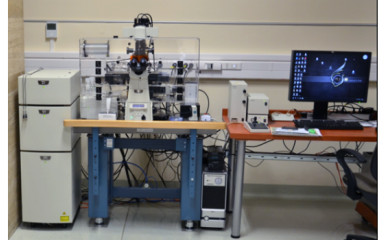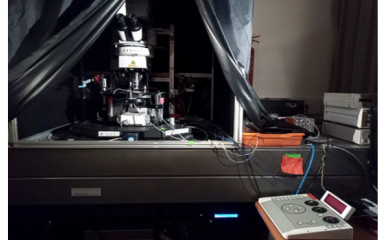Microscopes
.
No results


The A1R was the high-end confocal solution from Nikon. Our system is equipped with 6 laser lines and 4 separate photomultiplier units and a spectral detector as well. The detector unit contains several dichroic mirrors and emission filters that can be changed using motorized filter wheels. The scanning head contains a hybrid scanner system incorporating both galvano and resonant scanners giving the user the extra option of high speed data acquisition. Using the resonant scanner one can scan a 515x512 pixel area at 30 frames per second. The two scanners can even be used simultaneously in photoactivation/photobleaching experiments. In these cases the galvano scanner is used for the activation of a given area and the resonant scanner is used for imaging. A separate PMT can be used to detect transmitted light. This can also be used to create DIC images with a polarizing DIC filter cube, a Nomarski prisms in the condenser/under the objective, and an addition polarizer. The scan head is mounted on a fully motorized Nikon Ti Eclipse inverted microscope with high quality plan fluor and plan apo objectives (4X, 10x,20x,40x,60x(Water), 60x(Oil)). Fluorescent episcopic illumination is achieved using the CoolLED pE-300 illumination system and a set of DAPI, FITC and TRIC filter cubes. The setup is well suited for live cell imaging as it is outfitted with a SOLENT environmental chamber with controlled temperature, humidity and CO2 atmosphere. This system is a very advanced tool with it's motorized components in combination with the JOBS module of the NIS Elements software package.

The C2 plus microscope is Nikon’s “work horse” laser scanning microscope. The scanning unit is equipped on a fully motorized Nikon Eclipse (Ni-E) microscope body. Our C2 confocal system enables users to acquire up to four channel images (available laser lines are: 405nm, 488nm, 561nm and 640nm) using 3 highly sensitive photomultiplier (PMT) detectors. Besides the confocal mode users can use the microscope in widefield mode with the Nikon Intensilight illuminator, a Nikon DS-Fi3 5.9 MP color CMOS camera and DAPI, FITC and TRITC filter cubes. The extremely precise motorized stage along with the motorized objective turret and filter wheel allow users to devise advanced imaging schemes. The microscope is equipped with high quality plan fluor and plan apo objectives (4X, 10x,20x, 60x). This very robust microscope is very user friendly and suits for most biological applications.

The Nikon N-STORM system is one of the crown jewels among Nikon’s microscope systems. Stochastic Optical Reconstruction Microscopy (STORM) has been a revolutionary technique that achieves super-resolution by temporally separating the registration of individual fluorophores. The most used case is the application of photo-switchable dyes that have a reversible dark state in the appropriate medium. A powerful laser is used to drive almost all of these molecules into a dark state. Periodically a few molecules return to the ground state and due to continuous illumination are excited again and again until driven into dark state again. Recording these spatially separated blinking events and fitting the centroid of the Point Spread Function (PSF) results in a point list. This point list will finally outline the investigated structure and enables the system to reach about tenfold increase in lateral/axial resolution (20-60nm laterally and 50-100nm axially).
The microscope is a TIRF microscope equipped with a series of lenses that focus the laser onto the specimen to further increase the local light intensity 4x or 8X. The microscope is equipped with Nikon’s cutting edge Perfect Focus System that compensates for Z-drift. The unsurpassed stability achieved thanks to the PSF system is prerequisite for STORM imaging. The microscope laser board contains 4 lines: 405,488,561 and 642nm (out of which the 642 and 561 are high power lasers) and a series of high quality filter cubes (HQ Blue, HQ Green, HQ Red, Far-red STORM and Red/Far-Red Dual STORM cube). The microscope is also fitted with a C2 confocal scan head that allows correlative STORM-Confocal imaging. 4x, 10x, 20x Plan Fluor and a 100x TIRF Plan Apo objective is the choice of lenses.

The multiphoton confocal microscope enables excitation by simultaneous absorption of two or more near infrared photons by a single fluorescent molecule. Because of the small amount of absorption and scattering by the specimen, the near infrared light used for excitation penetrates deeper into the samples. An additional advantage is that the excited sample volume is diffraction limited in x-y-z, resulting in less photodamage and eliminates the need for a descanned pinhole. The resonant scanner is capable of imaging a wide area at 420 frames per second. The microscope has a large platform stage that can accommodate large samples - cells, tissues or whole organisms.


